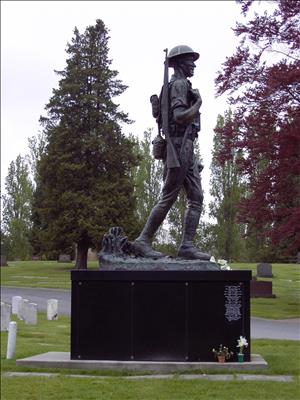The present-day Evergreen Washelli Cemetery straddles Aurora Avenue N beginning just beyond N 109th Street. Most members of David's branch of Denny family and that of his cousin Henry Levi Denny are buried there. Begun as the Oaklake Cemetery, Washelli entered into a series of mergers with the newly organized Evergreen Cemetery in the 1920s. As of 2015, Evergreen Washelli Cemetery maintained operations on grounds spanning both sides of Aurora Avenue N, overlooking interments dating from 1884 to the present.
Pioneer Burial Grounds
Seattle's surviving major cemeteries date from the pioneer period of the city's history: Lake View (1872), Mount Pleasant (1883), Evergreen Washelli (1884), and Calvary (1889). The first municipal cemetery in Seattle was the Seattle Cemetery (now Denny Park) on land also donated by David and Louisa Denny in 1864.
Burials of Seattle's deceased took place in church and informal graveyards until the first municipal cemetery, the Seattle Cemetery, was established on five acres in 1864 on Depot Street (now Denny Way and the site of Denny Park). In 1885, the municipal cemetery, including the majority of burials, moved to 40 acres of land on Capitol Hill acquired by the city in 1876. This second municipal cemetery, called Washelli after a Makah Indian word for west wind, received burials for three years until a city ordinance converted Washelli Cemetery into a public park named Lake View Park and renamed Volunteer Park in 1903. This forced some families to rebury their deceased for the fourth time. (Note that the first Washelli Cemetery and Lake View Park are often confused with the neighboring Lake View Cemetery, which was founded in 1872 by the St. John's Lodge of the Order of Freemasonry on land donated by David S. "Doc" Maynard).
Final Final Resting Place
In same year Washelli Cemetery opened, David and Louisa Denny buried their twin son, Jonathan, for the third time. Rather than a reburial at Washelli of the infant who had lived for only a few hours in 1867, the family chose the final resting place to be on a rolling hill site owned by the family near Oak Lake, north of Licton Springs. They would bury a daughter, Madge Decatur Denny there in 1889. Other family members, including David and Louisa, eventually followed. When Washelli Cemetery was disestablished in 1887, after only three years of existence, David's cousin Henry Levi Denny moved his family plot to the new Oaklake Cemetery. Other Seattleites who were not family members were permitted burials in other sections of the necropolis.
By the 1890s, Oaklake Cemetery was well established. The Denny family operated it until 1913 when David's son Victor, who had inherited it from his father, sold all of the holdings for $27,500. By now the cemetery consisted of two 40-acre tracts, with about half of it platted. Almost immediately the deed was transferred to the American Necropolis Corporation (ANC), which fully absorbed the cemetery by the next year. The corporation gave their new grounds the name Washelli, after Seattle's second municipal cemetery.
Working in conjunction with the Washelli Cemetery Association, made up of lot owners, ANC deeded columbarium and crematory additions in exchange for management rights, and introduced an endowment care fund built from the sale of lots to insure ongoing maintenance of the cemetery. A mausoleum was added in 1921.
Enter Evergreen Cemetery
If Washelli had the foresight to establish an endowment fund from sale of lots to maintain the grounds of the cemetery, the upstart Evergreen Cemetery Company of Seattle, which began to clear land directly across the North Trunk Highway in 1920, was visionary in the concept of perpetual care. Known today as "endowment care," once a cemetery has been filled to capacity, it will be maintained in perpetuity through money set aside from an endowment fund.
Originally planned as a housing development, the land for Evergreen Park Cemetery was cleared and its first burial completed in July 1920. A wrought iron fence dog-legged along its western boundary followed the rails of the Seattle-Everett Interurban Line. A break in the fence line at Groveland station (N 117th Street) still provides access to the cemetery through an iron turnstile. The Evergreen and Washelli cemeteries were separated physically by the North Trunk Highway and commercially by different ownership.
This changed in August 1922 when Evergreen Cemetery purchased Washelli from ANC and began a series of mergers that would continue until 1972. During that time Evergreen Washelli Cemetery expanded operations and services, culminating in purchase of the Evergreen Washelli Funeral Home that opened in December 1972 and moved to its present site in 1994.
Many Cemeteries
Over the decades Evergreen Washelli became cemeteries within a cemetery. The Veterans Memorial Cemetery was started in 1927, open to all U.S. veterans. Today 5,000 white marble markers make this section of the cemetery reminiscent of Arlington Cemetery. Buried here are several Congressional Medal of Honor recipients. A Chimes Tower to ring the hours overlooking the simple memorials was contributed in the 1950s by veterans' groups and families. Sectarian sections on the grounds are devoted to members of the Russian Orthodox, Greek Orthodox, Lutheran, and other theistic communities. Other sections are devoted to fraternal organizations and ethnic groups. A civic service memorial section welcomes police officers and firefighters who lose their lives in the line of duty.
Changes continued at Evergreen Washelli as the grave sites kept filling well more than a century after the beginnings of Oaklake Cemetery. In 1994 the funeral home, having outgrown its offices on the eastern site of Washelli, moved into larger quarters on the Evergreen side (at 11111 Aurora Avenue N). Four years later, the "Doughboy" statue, a World War I memorial, was given to the cemetery by the City of Seattle and moved from Seattle Center to the Veterans' Cemetery. "Doughboy" was rededicated there on Armistice Day, 1998.

